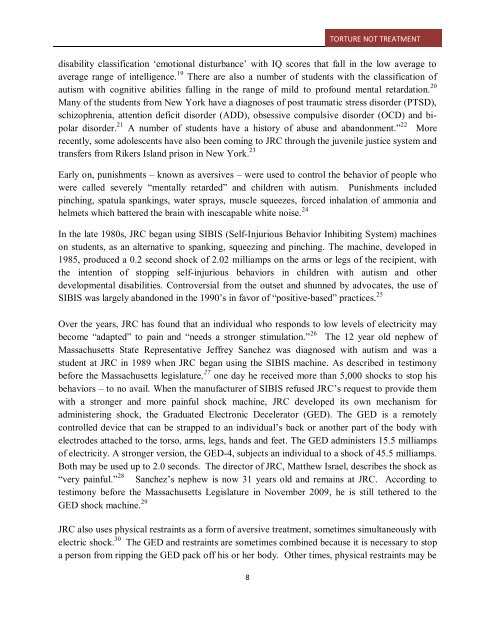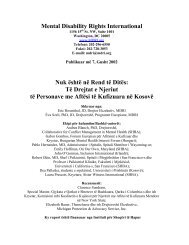Torture not Treatment - Disability Rights International
Torture not Treatment - Disability Rights International
Torture not Treatment - Disability Rights International
Create successful ePaper yourself
Turn your PDF publications into a flip-book with our unique Google optimized e-Paper software.
TORTURE NOT TREATMENT<br />
disability classification ‗emotional disturbance‘ with IQ scores that fall in the low average to<br />
average range of intelligence. 19 There are also a number of students with the classification of<br />
autism with cognitive abilities falling in the range of mild to profound mental retardation. 20<br />
Many of the students from New York have a diagnoses of post traumatic stress disorder (PTSD),<br />
schizophrenia, attention deficit disorder (ADD), obsessive compulsive disorder (OCD) and bipolar<br />
disorder. 21 A number of students have a history of abuse and abandonment.‖ 22 More<br />
recently, some adolescents have also been coming to JRC through the juvenile justice system and<br />
transfers from Rikers Island prison in New York. 23<br />
Early on, punishments – known as aversives – were used to control the behavior of people who<br />
were called severely ―mentally retarded‖ and children with autism. Punishments included<br />
pinching, spatula spankings, water sprays, muscle squeezes, forced inhalation of ammonia and<br />
helmets which battered the brain with inescapable white noise. 24<br />
In the late 1980s, JRC began using SIBIS (Self-Injurious Behavior Inhibiting System) machines<br />
on students, as an alternative to spanking, squeezing and pinching. The machine, developed in<br />
1985, produced a 0.2 second shock of 2.02 milliamps on the arms or legs of the recipient, with<br />
the intention of stopping self-injurious behaviors in children with autism and other<br />
developmental disabilities. Controversial from the outset and shunned by advocates, the use of<br />
SIBIS was largely abandoned in the 1990‘s in favor of ―positive-based‖ practices. 25<br />
Over the years, JRC has found that an individual who responds to low levels of electricity may<br />
become ―adapted‖ to pain and ―needs a stronger stimulation.‖ 26 The 12 year old nephew of<br />
Massachusetts State Representative Jeffrey Sanchez was diagnosed with autism and was a<br />
student at JRC in 1989 when JRC began using the SIBIS machine. As described in testimony<br />
before the Massachusetts legislature, 27 one day he received more than 5,000 shocks to stop his<br />
behaviors – to no avail. When the manufacturer of SIBIS refused JRC‘s request to provide them<br />
with a stronger and more painful shock machine, JRC developed its own mechanism for<br />
administering shock, the Graduated Electronic Decelerator (GED). The GED is a remotely<br />
controlled device that can be strapped to an individual‘s back or a<strong>not</strong>her part of the body with<br />
electrodes attached to the torso, arms, legs, hands and feet. The GED administers 15.5 milliamps<br />
of electricity. A stronger version, the GED-4, subjects an individual to a shock of 45.5 milliamps.<br />
Both may be used up to 2.0 seconds. The director of JRC, Matthew Israel, describes the shock as<br />
―very painful.‖ 28 Sanchez‘s nephew is now 31 years old and remains at JRC. According to<br />
testimony before the Massachusetts Legislature in November 2009, he is still tethered to the<br />
GED shock machine. 29<br />
JRC also uses physical restraints as a form of aversive treatment, sometimes simultaneously with<br />
electric shock. 30 The GED and restraints are sometimes combined because it is necessary to stop<br />
a person from ripping the GED pack off his or her body. Other times, physical restraints may be<br />
8




